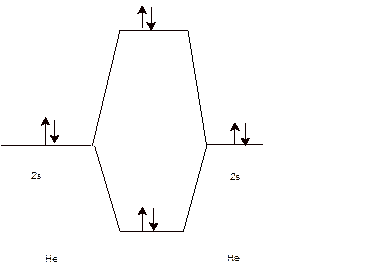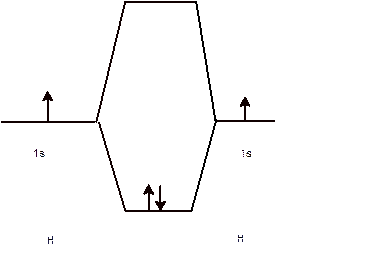
(a)
Interpretation: The reason of stability of
Concept Introduction: Molecular orbital theory explained the bonding, magnetic and spectral properties of molecule. It is based on the formation of molecular orbitals by the combination of atomic orbitals. On the basis of energy and stability these molecular orbitals can be further classified in three types:
- Bonding molecular orbitals (BMO): They have lesser energy than atomic orbital therefore more stable compare to atomic orbital.
- Antibonding molecular orbitals (ABMO): They have higher energy than atomic orbital therefore less stable compare to atomic orbital.
- Non-bonding molecular orbitals (NBMO): They have same energy as atomic orbital.
Molecular orbital diagrams represents the distribution of electrons in different molecular orbitals in increasing order of their energy. Hence lower energy molecular orbitals occupy first then only electron moves in higher energy orbitals.
(a)
Answer to Problem 39E
Since the bond order of
Explanation of Solution
To draw the energy level and Molecular orbital diagram for


Calculate bond order:
Since the bond order of
(b)
Interpretation: The reason of paramagnetic nature of
Concept Introduction: Molecular orbital theory explained the bonding, magnetic and spectral properties of molecule. It is based on the formation of molecular orbitals by the combination of atomic orbitals. On the basis of energy and stability these molecular orbitals can be further classified in three types:
- Bonding molecular orbitals (BMO): They have lesser energy than atomic orbital therefore more stable compare to atomic orbital.
- Antibonding molecular orbitals (ABMO): They have higher energy than atomic orbital therefore less stable compare to atomic orbital.
- Non-bonding molecular orbitals (NBMO): They have same energy as atomic orbital.
Molecular orbital diagrams represents the distribution of electrons in different molecular orbitals in increasing order of their energy. Hence lower energy molecular orbitals occupy first then only electron moves in higher energy orbitals.
(b)
Answer to Problem 39E
Only
Explanation of Solution
The molecular orbital electronic configuration of
Only
(c)
Interpretation: The reason of large
Concept Introduction: Molecular orbital theory explained the bonding, magnetic and spectral properties of molecule. It is based on the formation of molecular orbitals by the combination of atomic orbitals. On the basis of energy and stability these molecular orbitals can be further classified in three types:
- Bonding molecular orbitals (BMO): They have lesser energy than atomic orbital therefore more stable compare to atomic orbital.
- Antibonding molecular orbitals (ABMO): They have higher energy than atomic orbital therefore less stable compare to atomic orbital.
- Non-bonding molecular orbitals (NBMO): They have same energy as atomic orbital.
Molecular orbital diagrams represents the distribution of electrons in different molecular orbitals in increasing order of their energy. Hence lower energy molecular orbitals occupy first then only electron moves in higher energy orbitals.
(c)
Answer to Problem 39E
Since the bond order for
Explanation of Solution
The molecular orbital electronic configuration of
Calculate bond order:
Since the bond order for
(d)
Interpretation: The reason of more stability of
Concept Introduction: Molecular orbital theory explained the bonding, magnetic and spectral properties of molecule. It is based on the formation of molecular orbitals by the combination of atomic orbitals. On the basis of energy and stability these molecular orbitals can be further classified in three types:
- Bonding molecular orbitals (BMO): They have lesser energy than atomic orbital therefore more stable compare to atomic orbital.
- Antibonding molecular orbitals (ABMO): They have higher energy than atomic orbital therefore less stable compare to atomic orbital.
- Non-bonding molecular orbitals (NBMO): They have same energy as atomic orbital.
Molecular orbital diagrams represents the distribution of electrons in different molecular orbitals in increasing order of their energy. Hence lower energy molecular orbitals occupy first then only electron moves in higher energy orbitals.
(d)
Answer to Problem 39E
Since there are more anti-bonding electrons in
Explanation of Solution
The molecular orbital electronic configuration of
Number of electrons in N = 7
Number of electrons in O = 8
Total number of electrons in
Total number of electrons in
Calculate bond order:
Since there are more anti-bonding electrons in
Want to see more full solutions like this?
Chapter 14 Solutions
Chemical Principles
- Help with annotating the labeled peaks in the 'H NMR (solvent CDCls) spectra and 'H NMR (solvent Acetone-D6) spectra Also help with Calculating the keto-enol tautomerization Ka constant for the product in both solvents.Two solvents and two different Kaarrow_forwardDraw a Haworth projection of a common cyclic form of this monosaccharide CH₂OH HO H HO H H OH CH₂OHarrow_forwardCan you explain how I get these here and show the steps plz?arrow_forward
- Give the IUPAC name for this compound Hydrocarbon Condensed Formulas Hint C2H5 CH2CH3 expand that in all the formula Part A: (CH3)2CHCH(C2H5)CH2CH2CH3 Give the IUPAC name for this compound. Part B: CH2=C(C2H5)CH2CH2CH3 Give the IUPAC name for this compound. Part C: (CH3)2C=CHC(C2H5)=CH2 Give the IUPAC name for this compound. Part D: CH3C=CCH(C2H5)2 Give the IUPAC name for this compound. Part E: (CH3)3CC=CCH2CH=C(CH3)2arrow_forwardSelect/ Match the correct letter from the image below for the IUPAC names given below: A B C D 3 E F G H K L Part 1. 4-methylheptane For example.mmmm Answer Letter H _for part 1 Part 2. 2,4-dimethylhexane Part 3. 2,3-dimethylpentane Part 4. 2,2-dimethylhexane Part 5. 2-ethyl-1,1,3,3-tetramethylcyclopentane Part 6. 3-ethyl-2-methylpentanearrow_forwardCan u show the process as to how to get these?arrow_forward
- Sketch the expected 'H NMR spectra for the following compound. Label all of the H's in the structure and the corresponding signal for the spectra you sketch. Make sure you include the integration value and the splitting pattern for each signal Indicate how many signals you would expect in the 13C NMRarrow_forwardUse IUPAC naming rules to name the following hydrocarbon compounds: CH2-CH3 | a) CH-CH-CH2-CH-CH-CH3 b) | CH2 CH3 | CH3 CH3 \ / C=C H 1 H CH2-CH3 c) d) CH=C-CH3 e) CH3-CH2-CH2-CH=CH-CH3 f) CH2=CH-CH2-CH=CH-CH3 g) CH3-CH2-C = C-CH2-CH3 h)arrow_forwardQ5 Name the following : a. b. C. d. e.arrow_forward
- 25. Predict the major product of the following reaction. 1 equivalent of each of the starting materials was used. H₂C CH3 CH3 H3C H3C H3C. CH2 + H3C. heat CH3 CH H.C. CH3 H.C H.C CH3 CH CH3 CH3 A B C Earrow_forwardFind chemical structures based on the below information. a) Chemical formula C6H8O Compound is aromatic plus has two 1H NMR peaks that integrated for 3 each that are singlets (it could have more peaks in the 1H NMR b) Chemical Formula: C6H100 Compounds is conjugated 'H NMR has a signal that integrates for 6 and is a doublet IR spectra has a signal at 1730 cm-1arrow_forwardJaslev Propose a synthesis of the following starting from benzene and any other reagents and chemicals. No mechanisms are required. Indicate the condition for each step plus the major product for each step. More than two steps are required. Step 1 Step 2 مہد Brarrow_forward
 General Chemistry - Standalone book (MindTap Cour...ChemistryISBN:9781305580343Author:Steven D. Gammon, Ebbing, Darrell Ebbing, Steven D., Darrell; Gammon, Darrell Ebbing; Steven D. Gammon, Darrell D.; Gammon, Ebbing; Steven D. Gammon; DarrellPublisher:Cengage Learning
General Chemistry - Standalone book (MindTap Cour...ChemistryISBN:9781305580343Author:Steven D. Gammon, Ebbing, Darrell Ebbing, Steven D., Darrell; Gammon, Darrell Ebbing; Steven D. Gammon, Darrell D.; Gammon, Ebbing; Steven D. Gammon; DarrellPublisher:Cengage Learning Chemistry & Chemical ReactivityChemistryISBN:9781133949640Author:John C. Kotz, Paul M. Treichel, John Townsend, David TreichelPublisher:Cengage Learning
Chemistry & Chemical ReactivityChemistryISBN:9781133949640Author:John C. Kotz, Paul M. Treichel, John Townsend, David TreichelPublisher:Cengage Learning Chemistry & Chemical ReactivityChemistryISBN:9781337399074Author:John C. Kotz, Paul M. Treichel, John Townsend, David TreichelPublisher:Cengage Learning
Chemistry & Chemical ReactivityChemistryISBN:9781337399074Author:John C. Kotz, Paul M. Treichel, John Townsend, David TreichelPublisher:Cengage Learning Chemistry: The Molecular ScienceChemistryISBN:9781285199047Author:John W. Moore, Conrad L. StanitskiPublisher:Cengage Learning
Chemistry: The Molecular ScienceChemistryISBN:9781285199047Author:John W. Moore, Conrad L. StanitskiPublisher:Cengage Learning Chemistry: Principles and PracticeChemistryISBN:9780534420123Author:Daniel L. Reger, Scott R. Goode, David W. Ball, Edward MercerPublisher:Cengage Learning
Chemistry: Principles and PracticeChemistryISBN:9780534420123Author:Daniel L. Reger, Scott R. Goode, David W. Ball, Edward MercerPublisher:Cengage Learning Chemistry: Principles and ReactionsChemistryISBN:9781305079373Author:William L. Masterton, Cecile N. HurleyPublisher:Cengage Learning
Chemistry: Principles and ReactionsChemistryISBN:9781305079373Author:William L. Masterton, Cecile N. HurleyPublisher:Cengage Learning





